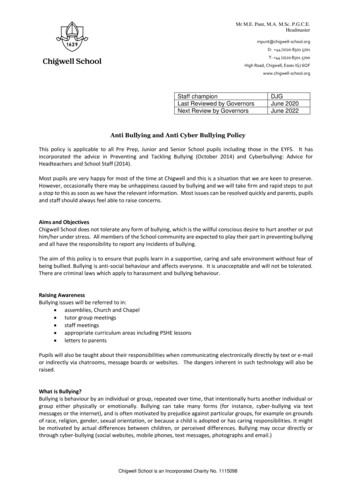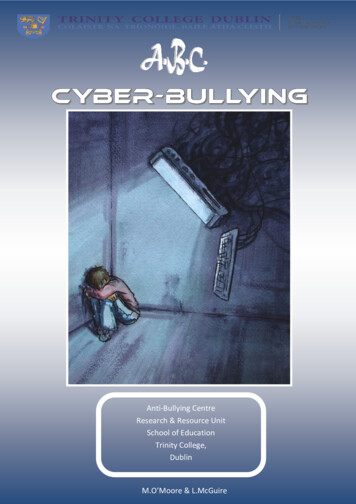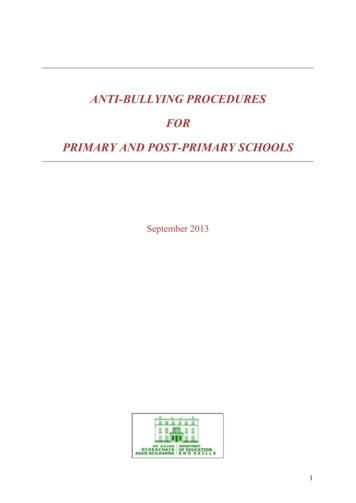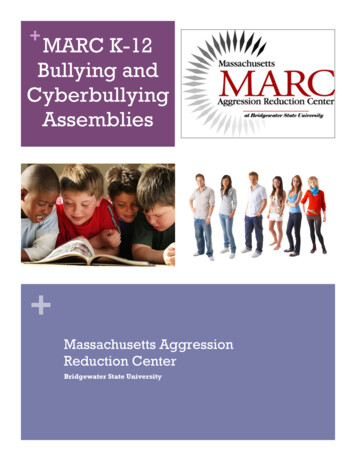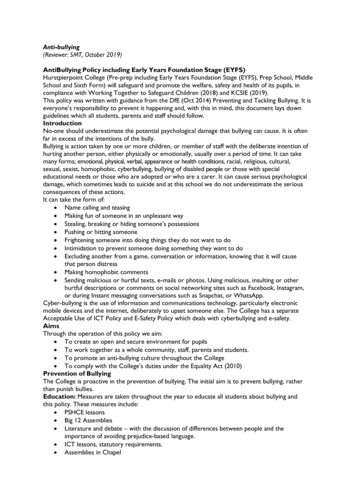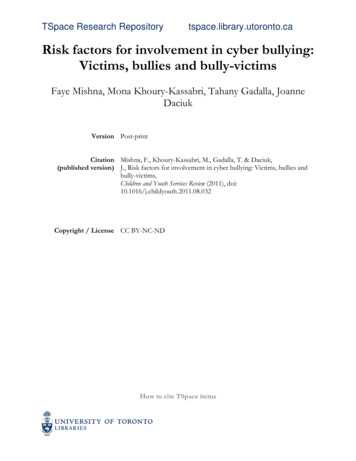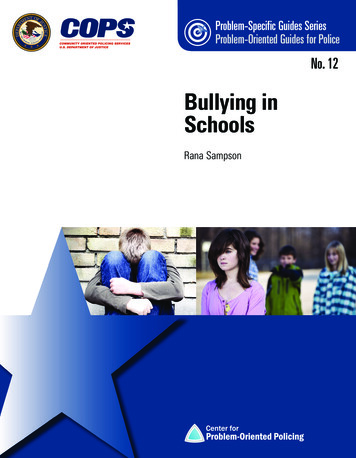
Transcription
Problem-Specific Guides SeriesProblem-Oriented Guides for PoliceNo. 12Bullying inSchoolsRana Sampson
Problem-Oriented Guides for PoliceProblem-Specific Guides SeriesNo. 12Bullying in SchoolsRana SampsonThis project was supported by cooperative agreement#99-CK-WX-K004 awarded by the U.S. Department of Justice, Officeof Community Oriented Policing Services (COPS Office). The opinionscontained herein are those of the author and do not necessarily representthe official position of the U.S. Department of Justice. Referencesto specific agencies, companies, products, or services should not beconsidered an endorsement of the product by the author or theU.S. Department of Justice. Rather, the references are illustrationsto supplement discussion of the issues.The Internet references cited in this publication were valid as of theoriginal date of this publication. Given that URLs and websites are inconstant flux, neither the author nor the COPS Office can vouch fortheir current validity. 2010 Center for Problem-Oriented Policing, Inc. The U.S. Departmentof Justice reserves a royalty-free, nonexclusive, and irrevocable license toreproduce, publish, or otherwise use, and authorize others to use, thispublication for Federal Government purposes. This publication may befreely distributed and used for noncommercial and educational purposes.www.cops.usdoj.govISBN: 1-932582-11-8Originally published in September 2003.Updated May 2012.
ContentsContentsAbout the Problem-Specific Guides Series . . . . . . . . . . . . . . . . . . . . . . . . . . . . . . . . . . . . . . 1Acknowledgments . . . . . . . . . . . . . . . . . . . . . . . . . . . . . . . . . . . . . . . . . . . . . . . . . . . . . . . . . . . 4The Problem of Bullying in Schools . . . . . . . . . . . . . . . . . . . . . . . . . . . . . . . . . . . . . . . . . . . . 5Definition of Bullying . . . . . . . . . . . . . . . . . . . . . . . . . . . . . . . . . . . . . . . . . . . . . . . . . . . . . 6Related Problems . . . . . . . . . . . . . . . . . . . . . . . . . . . . . . . . . . . . . . . . . . . . . . . . . . . . . . . . 7Extent of the Bullying Problem . . . . . . . . . . . . . . . . . . . . . . . . . . . . . . . . . . . . . . . . . . . . . . 7A Threshold Problem: The Reluctance To Report . . . . . . . . . . . . . . . . . . . . . . . . . . . . . . . . 8Bullying Behavior . . . . . . . . . . . . . . . . . . . . . . . . . . . . . . . . . . . . . . . . . . . . . . . . . . . . . . . . 9Bullies . . . . . . . . . . . . . . . . . . . . . . . . . . . . . . . . . . . . . . . . . . . . . . . . . . . . . . . . . . . . . . . . 11Incidents of Bullying . . . . . . . . . . . . . . . . . . . . . . . . . . . . . . . . . . . . . . . . . . . . . . . . . . . . . 12Victims of Bullying . . . . . . . . . . . . . . . . . . . . . . . . . . . . . . . . . . . . . . . . . . . . . . . . . . . . . . 13Consequences of Bullying . . . . . . . . . . . . . . . . . . . . . . . . . . . . . . . . . . . . . . . . . . . . . . . . . 14Chronic Victims of Bullying . . . . . . . . . . . . . . . . . . . . . . . . . . . . . . . . . . . . . . . . . . . . . . . . 14Understanding Your Local Problem . . . . . . . . . . . . . . . . . . . . . . . . . . . . . . . . . . . . . . . . . . . 17Asking the Right Questions . . . . . . . . . . . . . . . . . . . . . . . . . . . . . . . . . . . . . . . . . . . . . . . . 17The School . . . . . . . . . . . . . . . . . . . . . . . . . . . . . . . . . . . . . . . . . . . . . . . . . . . . . . . . 17Offenders . . . . . . . . . . . . . . . . . . . . . . . . . . . . . . . . . . . . . . . . . . . . . . . . . . . . . . . . . 18Victims and Victimization . . . . . . . . . . . . . . . . . . . . . . . . . . . . . . . . . . . . . . . . . . . . . 18Locations Where Bullying Occurs . . . . . . . . . . . . . . . . . . . . . . . . . . . . . . . . . . . . . . 18Measuring Your Effectiveness . . . . . . . . . . . . . . . . . . . . . . . . . . . . . . . . . . . . . . . . . . . . . 19Responses to the Problem of Bullyingin Schools . . . . . . . . . . . . . . . . . . . . . . . . . . . . . . . . . . . . . . . . . . . . . . . . . . . . . . . . . . . . . . . . . 21General Requirements for an Effective Strategy To Counter Bullying in Schools . . . . . . 21Specific Responses To Reduce Bullying in Schools . . . . . . . . . . . . . . . . . . . . . . . . . . . . . 22Responses With Limited Effectiveness . . . . . . . . . . . . . . . . . . . . . . . . . . . . . . . . . . . . . . 24Appendix A: Summary of Responses to Bullying in Schools . . . . . . . . . . . . . . . . . . . . . . 27Appendix B: Sample Brochure Educating Parents About School Bullying . . . . . . . . . 32References . . . . . . . . . . . . . . . . . . . . . . . . . . . . . . . . . . . . . . . . . . . . . . . . . . . . . . . . . . . . . . . . 35Endnotes . . . . . . . . . . . . . . . . . . . . . . . . . . . . . . . . . . . . . . . . . . . . . . . . . . . . . . . . . . . . . . . . . . 39About the Author . . . . . . . . . . . . . . . . . . . . . . . . . . . . . . . . . . . . . . . . . . . . . . . . . . . . . . . . . . . 42Other Problem-Oriented Guides for Police . . . . . . . . . . . . . . . . . . . . . . . . . . . . . . . . . . . . . 43
About the Problem-Specific Guides SeriesAbout the Problem-Specific Guides SeriesThe Problem-Specific Guides summarize knowledge about how police can reduce theharm caused by specific crime and disorder problems. They are guides to prevention andto improving the overall response to incidents, not to investigating offenses or handlingspecific incidents. Neither do they cover all of the technical details about how to implementspecific responses. The guides are written for police—of whatever rank or assignment—who must address the specific problem the guides cover. The guides will be most useful toofficers who: Understand basic problem-oriented policing principles and methods. Theguides are not primers in problem-oriented policing. They deal only briefly with theinitial decision to focus on a particular problem, methods to analyze the problem,and means to assess the results of a problem-oriented policing project. They aredesigned to help police decide how best to analyze and address a problem theyhave already identified. (A companion series of Problem-Solving Tools guides hasbeen produced to aid in various aspects of problem analysis and assessment.) Can look at a problem in depth. Depending on the complexity of the problem,you should be prepared to spend perhaps weeks, or even months, analyzing andresponding to it. Carefully studying a problem before responding helps youdesign the right strategy, one that is most likely to work in your community.You should not blindly adopt the responses others have used; you must decidewhether they are appropriate to your local situation. What is true in one placemay not be true elsewhere; what works in one place may not work everywhere. Are willing to consider new ways of doing police business. The guides describeresponses that other police departments have used or that researchers have tested.While not all of these responses will be appropriate to your particular problem, theyshould help give a broader view of the kinds of things you could do. You may thinkyou cannot implement some of these responses in your jurisdiction, but perhaps youcan. In many places, when police have discovered a more effective response, theyhave succeeded in having laws and policies changed, improving the response to theproblem. (A companion series of Response Guides has been produced to help youunderstand how commonly-used police responses work on a variety of problems.) 1
Bullying in Schools Understand the value and the limits of research knowledge. For some typesof problems, a lot of useful research is available to the police; for other problems,little is available. Accordingly, some guides in this series summarize existing researchwhereas other guides illustrate the need for more research on that particular problem.Regardless, research has not provided definitive answers to all the questions youmight have about the problem. The research may help get you started in designingyour own responses, but it cannot tell you exactly what to do. This will dependgreatly on the particular nature of your local problem. In the interest of keeping theguides readable, not every piece of relevant research has been cited, nor has everypoint been attributed to its sources. To have done so would have overwhelmed anddistracted the reader. The references listed at the end of each guide are those drawnon most heavily; they are not a complete bibliography of research on the subject. Are willing to work with others to find effective solutions to the problem. Thepolice alone cannot implement many of the responses discussed in the guides. Theymust frequently implement them in partnership with other responsible private andpublic bodies, including other government agencies, non-governmental organizations,private businesses, public utilities, community groups, and individual citizens. Aneffective problem-solver must know how to forge genuine partnerships with othersand be prepared to invest considerable effort in making these partnerships work.Each guide identifies particular individuals or groups in the community with whompolice might work to improve the overall response to that problem. Thoroughanalysis of problems often reveals that individuals and groups other than the policeare in a stronger position to address problems and that police ought to shift somegreater responsibility to them to do so. Response Guide No. 3, Shifting and SharingResponsibility for Public Safety Problems, provides further discussion of this topic.The COPS Office defines community policing as “a philosophy that promotesorganizational strategies, which support the systematic use of partnerships and problemsolving techniques, to proactively address the immediate conditions that give rise to publicsafety issues such as crime, social disorder, and fear of crime.” These guides emphasizeproblem-solving and police-community partnerships in the context of addressing specificpublic safety problems. For the most part, the organizational strategies that can facilitateproblem-solving and police-community partnerships vary considerably and discussion ofthem is beyond the scope of these guides. 2
About the Problem-Specific Guides SeriesThese guides have drawn on research findings and police practices in the United States,the United Kingdom, Canada, Australia, New Zealand, the Netherlands, and Scandinavia.Even though laws, customs, and police practices vary from country to country, it is apparentthat the police everywhere experience common problems. In a world that is becomingincreasingly interconnected, it is important that police be aware of research and successfulpractices beyond the borders of their own countries.Each guide is informed by a thorough review of the research literature and reported policepractice, and each guide is anonymously peer-reviewed by a line police officer, a policeexecutive, and a researcher prior to publication. The review process is independentlymanaged by the COPS Office, which solicits the reviews.For more information about problem-oriented policing, visit the Center for ProblemOriented Policing online at www.popcenter.org. This website offers free online access to: The Problem-Specific Guides series The companion Response Guides and Problem-Solving Tools series Special publications on crime analysis and on policing terrorism Instructional information about problem-oriented policing and related topics An interactive problem-oriented policing training exercise An interactive Problem Analysis Module Online access to important police research and practices Information about problem-oriented policing conferences and award programs 3
Bullying in SchoolsAcknowledgmentsThe Problem-Oriented Guides for Police are produced by the Center for Problem-OrientedPolicing, whose officers are Michael S. Scott (Director), Ronald V. Clarke (AssociateDirector), and Graeme R. Newman (Associate Director). While each guide has a primaryauthor, other project team members, COPS Office staff, and anonymous peer reviewerscontributed to each guide by proposing text, recommending research, and offeringsuggestions on matters of format and style.The project team that developed the guide series comprised Herman Goldstein (Universityof Wisconsin Law School), Ronald V. Clarke (Rutgers University), John E. Eck (Universityof Cincinnati), Michael S. Scott (University of Wisconsin Law School), Rana Sampson(Police Consultant), and Deborah
Problem-Oriented Guides for Police Problem-Specific Guides Series No. 12 Bullying in Schools . Rana Sampson . This project was supported by cooperative agreement

